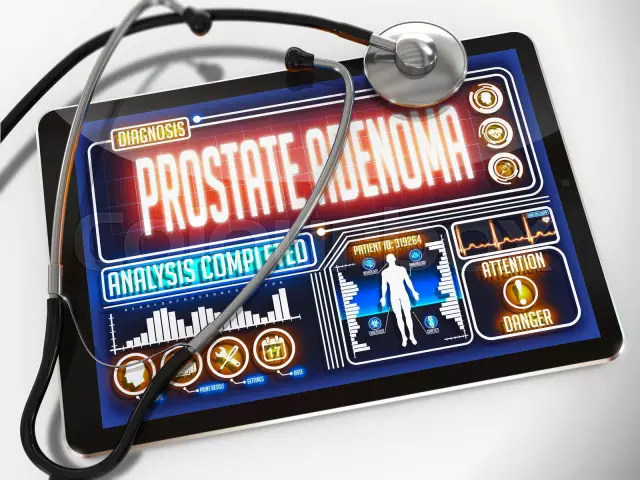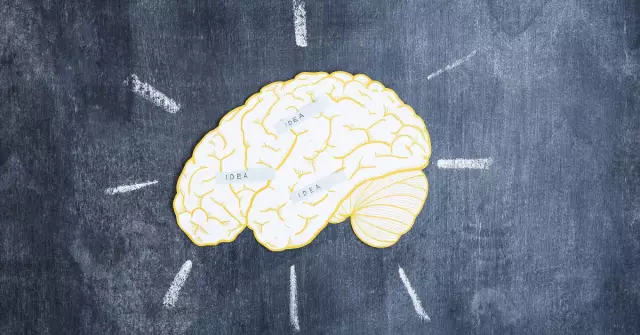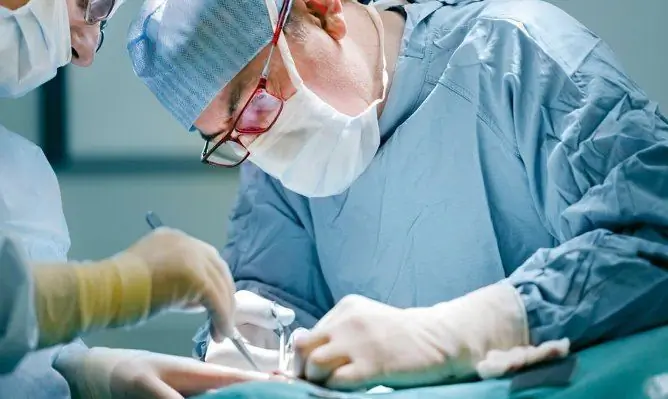- Author Rachel Wainwright [email protected].
- Public 2023-12-15 07:39.
- Last modified 2025-11-02 20:14.
Varicocele
General characteristics of the disease
Varicocele is an enlargement of the veins that surround the spermatic cord and testicle.

This disease in many cases is the cause of male infertility - thermoregulation and supply of testicular tissue are disturbed, which, in turn, leads to a deterioration in the morphological parameters and mobility of spermatozoa, a decrease in their number.
Varicocele is one of the most common diseases of the male reproductive system. This pathology can be bilateral, right-sided and left-sided, while the latter type accounts for about 90% of all cases.
With varicocele, surgery is necessary already at the stage of determining the disease, otherwise testicular atrophy is possible.
Causes of the disease
Varicocele is caused by reverse blood flow in the testicular vein, which can result from congenital weakness of the vascular wall or increased blood pressure in the veins of the scrotum or pelvis. In the first case, the disease arises as a result of a genetic predisposition - relatives may have heart valve defects, flat feet, phimosis, varicose veins of the extremities or other diseases associated with insufficient connective tissue. In the second case, varicocele is caused by the absence or poor functioning of the valves existing in the veins, which should serve as an obstacle to the reverse flow of blood. Disruption of these valves leads to the fact that an increase in pressure in the veins during physical exertion or when in an upright position causes the expansion of the venous vessels.
Diagnosis and symptoms of varicocele
The disease can be diagnosed in several ways: palpation of the plexus plexus, ultrasound and Doppler ultrasound in standing and lying position, Valsalva test (strong exhalation with closed mouth and nose, with tense abdominal press). Also, the level of sex hormones in the blood can be examined, and a spermogram is done.
The clinical symptoms of varicocele are minor:
- omission of the left half;
- an increase in half of the scrotum;
- not very pronounced pain in the testicles, scrotum, in the groin area, usually of a pulling character;
- increased pain with exercise, sexual arousal or walking.
If treatment was not started in a timely manner, the symptoms of varicocele may worsen: constant and prolonged pain, a decrease in the left testicle, a significant increase in the scrotum, contouring of the veins of the spermatic cord.
There are four degrees of varicocele:
1. In the first degree, the disease can be detected only by ultrasound or Valsalva's test, which will confirm an increase in the plexus plexus.
2. With the second degree of varicocele, the dilated veins can be seen with the naked eye while standing.
3. At the third degree, palpation both in the supine position and in the standing position will diagnose the disease.
4. With the fourth degree of varicocele, the dilated veins can be seen with the naked eye, while the testicle is soft to the touch, and its size is reduced.
In most cases, varicocele is found during some kind of medical examination, for example, pre-conscripts or for infertility.
Varicocele treatment

Today, for varicocele, surgery is the only treatment that allows you to preserve spermatogenesis.
There are several ways to treat the disease surgically, however, as a rule, for varicocele, the operation involves removing part of the dilated veins or hanging the testicle by the lower pole (using a strip of aponeurosis of the oblique abdominal muscle).
If the symptoms of the disease do not bother, and the man does not plan to have children, varicocele can be treated non-surgically, for example, by wearing a suspensor.
Complications of the surgical treatment of varicocele
After varicocele, in some cases, the following unpleasant moments may be observed:
- In the early postoperative period, ligation and damage to the lymphatic vessels can provoke lymphostasis. This phenomenon occurs in the first days after varicocele quite often, however, as a rule, within two weeks, the soreness and swelling of the scrotum completely disappear.
- The most formidable complication of the surgical treatment of varicocele can be testicular atrophy or hypotrophy. This phenomenon can be provoked by accidental ligation of the seminal artery. A decrease in testicular volume, up to atrophy, is observed in less than 1% of cases of microsurgical treatments.
- After varicocele, pain decreases or disappears in 90% of cases, however, every 3-5 men out of 100 operated on continue to be bothered by pain in the testicle and spermatic cord. Such pain can persist for quite a long time, sometimes for several years.
- The intersection of the lymphatic vessels ½-4 years after the operation, and sometimes in the first months, in 0.5-9% of patients can provoke a hydrocele (dropsy of the testicle). Since the microsurgical technique for treating varicocele involves the preservation of lymph nodes, in this case, this complication occurs in less than 1% of patients.
- In adult men, the recurrence of varicocele is observed less frequently than in children - 2-9% and 1-20%, respectively. In this regard, many urologists advise to treat this disease by surgery after puberty.
The success of varicocele treatment is evidenced by the improvement in the quantitative and qualitative characteristics of sperm, observed after surgery, usually after 3-6 months.
YouTube video related to the article:
The information is generalized and provided for informational purposes only. At the first sign of illness, see your doctor. Self-medication is hazardous to health!






